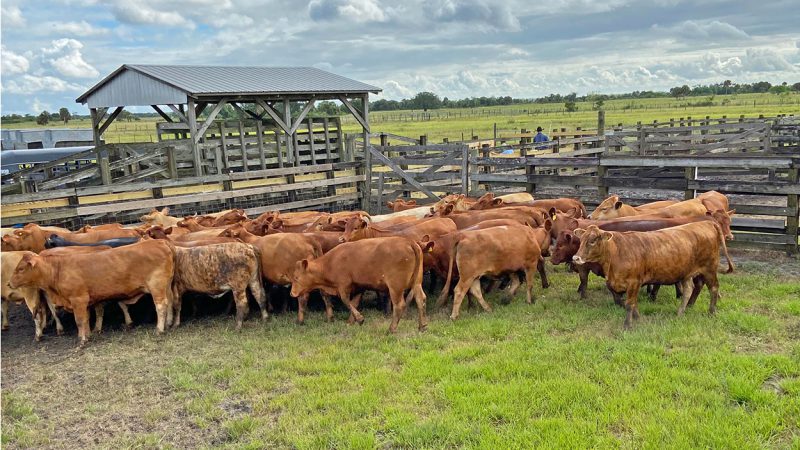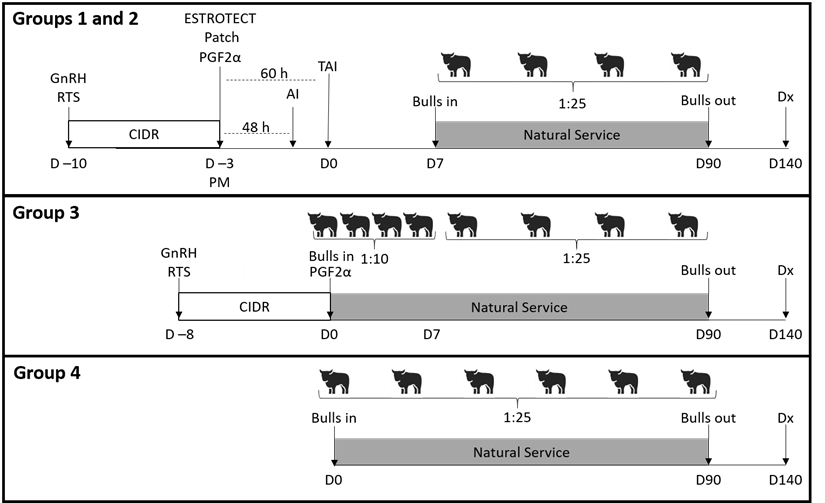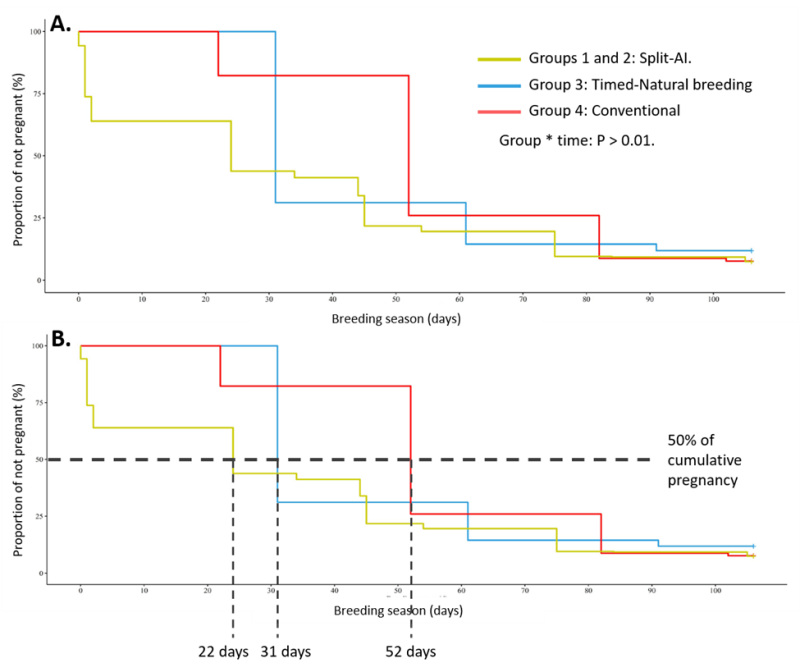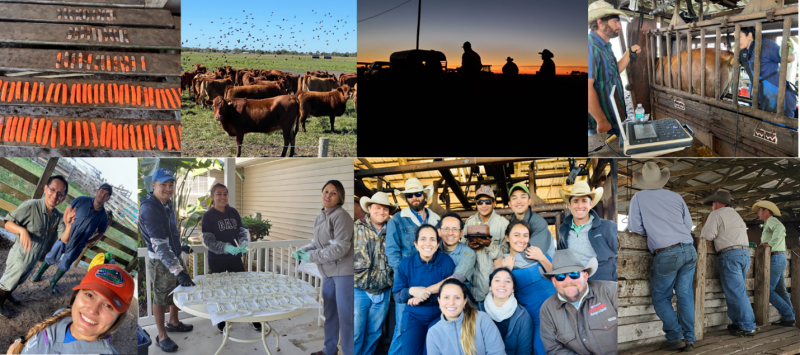
Developing heifers is one of the most critical areas of focus for beef herd management. Heifers that get pregnant early in the season are more likely to be bred again the next season. Yearling heifers at Rollins Ranch were ready for the 2020 breeding season. Credit: Angela Gonella, UF/IFAS
Angela Gonella-Diaza, Cattle Reproduction Specialist, Oscar Alejandro Ojeda-Rojas, PhD., Daniella Heredia, MSc., Sergio Lasso, Maria Camila Londono Mendez, Guido Exequiel Enriquez, UF/IFAS. North Florida Research and Education Center
Developing heifers is one of the most critical areas of focus for beef herd management. The cost of developing replacement represents an essential portion of the production cost. In the ideal scenario, heifers will calve by 24 months of age to achieve maximum lifetime productivity. Heifers who conceive late in the breeding season will likely not have enough time to recover from calving to rebreed in the next breeding season. Thus, they will have a higher risk of being prematurely culled. Heifers that get pregnant early in the season will calve early in the calving season. Therefore, their calves will have more time to grow before weaning. This is important to overall profitability since the age of a calf at weaning is the most significant factor affecting weaning weight. All heifer development programs should aim to have heifers that have reached puberty with good fertility at the start of the breeding season. This article will highlight data collected during the 2020 breeding season from a trial at Rollins Ranches, Vero Beach and Okeechobee, Florida.
Rollins Ranches’ team invited our Cattle Reproduction Research Team to participate in a trial for the 2020 breeding season. They had 712 crossbred yearling heifers divided into four pastures. Heifers were vaccinated with all pre-breeding shots. A trained Veterinarian conducted reproductive Tract Score (RTS) evaluations 30 days before the beginning of the season. Next, groups of heifers were allocated in 3 reproductive programs (Figure 1).

Figure 1: Reproductive management programs used for breeding heifers in the study. For details, please see the text.
–
Group 1 (197 heifers) and 2 (187 heifers): Split AI program
The reproductive management used on these two groups consisted of using the 7 day co-synch + CIDR protocol. Briefly, an intravaginal progesterone device (Eazi-Breed™ CIDR; Zoetis) was placed in the vagina, and a dose of GnRH (2 mL of FACTREL; Zoetis) was injected intramuscularly. After seven days, the CIDR was pulled out, and a dose of prostaglandin F2 alpha (5 mL of Lutalyse; Zoetis) was administered. Also, we positioned a heat detection patch at the base of the tail. Thirty-six hours later, we checked the patches for signs of heat. Heifers that came into heat earlier were inseminated 12 hours later (around 48 hours after CIDR removal). Heifers that came into heat 48 hours after CIDR removal and heifers that did not show heat were inseminated 60 hours after CIDR removal. Bulls were turned in with the heifers 8 days after the final AI in a proportion of 1 bull per 25 heifers.
Group 3 (147 heifers): Timed Natural breeding program
The timed-natural breeding program was also based on the 7 day co-synch + CIDR protocol. Heifers received a dose of GnRH and a CIDR. Seven days later, the CIDR was removed, and a dose of prostaglandin was administrated. This group of heifers was not inseminated. Immediately after CIDR removal, bulls were turned in with heifers in a proportion of 1 bull per 12 heifers for the first 8 days. Later, on day 9, the ratio was set as one bull to 22 heifers through the end of the season.
Group 4 (181 heifers): Conventional program
Bulls were turned in with the heifers the first day of the season in a proportion of 1 bull per 22 heifers.
In the two groups that were artificially inseminated, a pregnancy check was conducted 30 days after the AI. Bulls were removed around the same time for all groups to complete a 90 days breeding season. On day 140, all groups were checked for pregnancy, and the age of gestation was estimated using transrectal ultrasonography.
Summarizing the results of the two groups of heifers included in the AI program (Groups 1 and 2), 40% (152/384) of the heifers got pregnant after a single AI. At the end of the breeding season, 93% (357/384) were pregnant, including AI and natural service pregnancies. Additionally, 91% (134/147) of the heifers got pregnant by the end of the breeding season in group 3 (Timed-Natural breeding program) and and 92% (167/181) in group 4 (Conventional program). As you can see, these were great results for all groups enrolled in the study. The final pregnancy rate of the ranch, including all four groups together, was 92% (658/712). This means that only 8% (54/712) of the heifers remained open at the end of the breeding season. The pregnancy rate was not statistically different when comparing the four groups. However, there was a significant effect of the reproductive program when evaluating the time to pregnancy, as shown in figure 2.

Figure 2: Survival chart showing the proportion of open heifers during the 90 days breeding season. In the bottom panel, 50% of pregnancy has been highlighted.
–
Figure 2A shows a survival plot. To understand this plot, please see that the vertical access represents the proportion of open heifers, and the horizontal axes represent the days of the breeding season. As you can see, as time progresses, more heifers are becoming pregnant during the season, and accordingly, lines representing each reproductive program are going down. This indicates that that the proportion of open heifers decreases as the breeding season passes. So, if you compare the three lines (yellow, red, and blue), you will see that those lines have a different “behavior.”
Let’s analyze this in more detail. Figure 2B shows the same survival plot as 2A, but this time we add a black dashed line to highlight the 50% of cumulative pregnancy. This represents the point in time in which 50% of the heifers were pregnant. Now, let’s see what happens with our heifers in each one of the reproductive programs. The yellow line, which represents the split-AI program, indicates that the 50% cumulative pregnancies are achieved after 22 days of the breeding season. This makes sense if you consider that 40% of the heifers were AI bred on the very first day of the season. The blue line represents the group of heifers submitted to the timed-natural breeding program. This group required 31 days to have 50% of pregnant heifers. Finally, the red line represents the conventional program, where no synchronization was performed. In this case, 52 days were required to have 50% of pregnant heifers.
So, both strategies that involve the use of estrus synchronization, with or without AI, resulted in more heifers getting bred sooner than did the conventional program. Therefore, the calving season of groups 1, 2, and 3 was more compact. This means that a more significant proportion of heifers calved at the beginning of the calving season and consequently producing heavier and more homogeneous calves at weaning, and were more likely to be rebred and remain productive in the herd.
–
–
We want to thank Ty Bennet, Darrel With, and Leah Massey from Rollins Ranches for this beautiful experience and the opportunity to conduct our research with them (Figure 3).
We leave you with this question:
–
What have you done to increase the reproductive efficiency of your herd?
- Heat Stress and its Impact on Cattle Reproduction - March 14, 2025
- Fall is Here.Time for Pregnancy Testing Cattle! - September 13, 2024
- How Stress Impacts Cattle Reproduction - March 15, 2024

